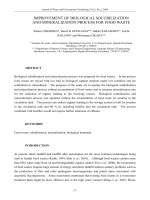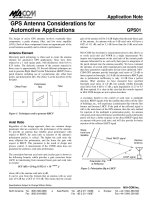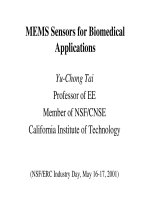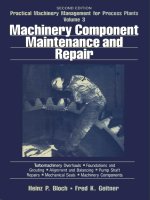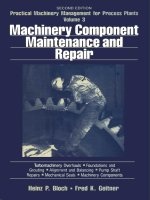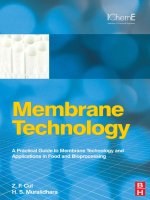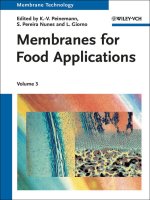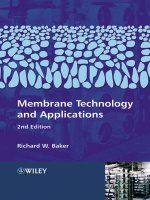membrane technology volume 3 membranes for food applications
Bạn đang xem bản rút gọn của tài liệu. Xem và tải ngay bản đầy đủ của tài liệu tại đây (3.18 MB, 265 trang )
Edited by
Klaus-Viktor Peinemann,
Suzana Pereira Nunes,
and Lidietta Giorno
Membrane Technology
Related Titles
Peinemann, Klaus-Viktor /
Pereira Nunes, Suzana (eds.)
Membrane Technology
6 Volume Set
2011
ISBN-13: 978-3-527-31479-9
Rijk, Rinus / Veraart, Rob (eds.)
Global Legislation for Food
Packaging Materials
2010
ISBN: 978-3-527-31912-1P
Drioli, Enrico / Giorno, Lidietta (Hrsg.)
Membrane Operations
Innovative Separations and
Transformations
2009
ISBN-13: 978-3-527-32038-7
Heimburg, Thomas
Thermal Biophysics of
Membranes
Tutorials in Biophysics (Band 1)
2007
ISBN-13: 978-3-527-40471-1
Pereira Nunes, S., Peinemann, K V.
(eds.)
Membrane Technology
in the Chemical Industry
2006
ISBN: 978-3-527-31316-7
Sammells, A. F., Mundschau, M. V. (eds.)
Nonporous Inorganic
Membranes for Chemical
Processing
2006
ISBN: 978-3-527-31342-6
Freeman, B., Yampolskii, Y., Pinnau, I.
(eds.)
Materials Science of
Membranes for Gas
and Vapor Separation
2006
ISBN: 978-0-470-85345-0
Ohlrogge, K., Ebert, K. (eds.)
Membranen
Grundlagen, Verfahren und industrielle
Anwendungen
2006
ISBN: 978-3-527-30979-5
Membrane Technology
Volume 3: Membranes for Food Applications
Edited by
Klaus-Viktor Peinemann, Suzana Pereira Nunes, and
Lidietta Giorno
The Editors
Dr. Klaus-Viktor Peinemann
KAUST
Membranes Research Center
Bldg.2, 3rd Floor,Room 3216-W9
4700 King Abdullah Univ.
23955-6900 Thuwal
Saudi Arabia
Dr. Suzana Pereira Nunes
KAUST
Membranes Research Center
Bldg.2, 3rd Floor,Room 3216-W9
4700 King Abdullah Univ.
23955-6900 Thuwal
Saudi Arabia
Prof. Lidietta Giorno
University of Calabria
Institute on Membrane Technology
Via P. Bucci 17/C
87036 Rende (CS)
Italia
All books published by Wiley-VCH are carefully
produced. Nevertheless, authors, editors, and
publisher do not warrant the information contained
in these books, including this book, to be free of
errors. Readers are advised to keep in mind that
statements, data, illustrations, procedural details or
other items may inadve rtently be inaccurate.
Library of Congress Card No.: applied for
British Library Cataloguing-in-Publication Data
A catalogue record for this book is available from the
British Library.
Bibliographic information published by
the Deutsche Nationalbibliothek
The Deutsche Nationalbibliothek lists this
publication in the Deutsche Nationalbibliografie;
detailed bibliographic data are available on the
Internet at .
# 2010 WILEY-VCH Verlag GmbH & Co. KGaA,
Boschstr. 12, 69469 Weinheim
All rights reserved (including those of translation into
other languages). No part of this book may be
reproduced in any form – by photoprinting,
microfilm, or any other means – nor transmitted or
translated into a machine language without written
permission from the publishers. Registered names,
trademarks, etc. used in this book, even when not
specifically marked as such, are not to be considered
unprotected by law.
Cover Design Adam Design, Weinheim
Typesetting Thomson Digital, Noida, India
Printing and Binding betz-druck GmbH, Darmstadt
Printed in the Federal Republic of Germany
Printed on acid-free paper
ISBN: 978-3-527-31482-9
Contents
Preface XI
List of Contributors XIII
1 Cross-Flow Membrane Applications in the Food Industry 1
Frank Lipnizki
1.1 Introduction 1
1.2 Dairy Industry 2
1.2.1 Dairy Industry Overview 2
1.2.2 Key Membrane Applications 3
1.2.2.1 Removal of Bacteria and Spores from Milk, Whey and Cheese Brine 3
1.2.2.2 Milk Protein Standardization, Concentration and Fractionation 5
1.2.2.3 Whey Protein Concentration and Fractionation 5
1.2.2.4 Whey Demineralization 7
1.2.2.5 Cheese Manufacturing 8
1.3 Fermented Food Products 9
1.3.1 Beer 9
1.3.1.1 Beer from Tank Bottoms/Recovery of Surplus Yeast 9
1.3.1.2 Beer Clarification 11
1.3.1.3 Beer Dealcoholization 11
1.3.2 Wine 12
1.3.2.1 Must Correction 13
1.3.2.2 Clarification of Wine 13
1.3.2.3 Rejuvenation of Old Wine (Lifting) 13
1.3.2.4 Alcohol Removal 14
1.3.3 Vinegar 14
1.3.3.1 Clarification of Vinegar 15
1.4 Fruit Juices 15
1.4.1 Fruit-Juice Clarification 16
1.4.2 Fruit-Juice Concentration 17
1.5 Other Membrane Applications in the Food Industry 17
V
1.5.1 Membrane Processes as Production Step 18
1.5.2 Membrane Processes for Water and Wastewater 18
1.6 Future Trends 18
1.6.1 New Applications of Membrane Processes 20
1.6.2 New Membrane Processes 20
1.6.2.1 Pervaporation 21
1.6.2.2 Electrodialysis 21
1.6.2.3 Membrane Contactors – Osmotic Distillation 22
1.6.3 Integrated Process Solutions: Synergies and Hybrid Processes 23
References 23
2 Membrane Processes for Dairy Fractionation 25
Karin Schroën, Anna M.C. van Dinther, Solomon Bogale,
Martijntje Vollebregt, Gerben Brans, and Remko M. Boom
2.1 Introduction 25
2.2 Membrane Separation of Components 27
2.2.1 Removal of Milk Fat from Whole Milk 27
2.2.2 Removal of Bacteria and Spores from Skim Milk
(Cold Pasteurization) 27
2.2.3 Concentration of Casein Micelles in Skim Milk 28
2.2.4 Recovery of Serum Proteins from Cheese Whey 30
2.3 Methods to Enhance Membrane Separation 30
2.3.1 Critical Flux Concept 31
2.3.2 Uniform Low Transmembrane Pressure Concept (UTP) 32
2.3.3 Turbulence Promotion 32
2.3.4 Backpulsing and Flow Reversal 33
2.3.5 Other Methods 33
2.4 Use of Models for Membrane Separation 34
2.5 How to Get from Separation to Fractionation 35
2.5.1 Membranes with Uniform Pore Size 36
2.5.2 Simulation of Particle Behavior 37
2.5.3 Membrane Modification 37
2.6 Outlook 38
References 39
3 Milk and Dairy Effluents Processing: Comparison of Cross-Flow
and Dynamic Filtrations 45
Michel Y. Jaffrin, Valentina S. Espina, and Matthieu Frappart
3.1 Introduction 45
3.1.1 Properties and Applications of Various Proteins 45
3.1.1.1 Caseins 45
3.1.1.2 Whey Proteins 45
3.2 Applications of Membrane Cross-Flow Filtration to Milk Processing 46
3.2.1 Milk Microfiltration 46
3.2.1.1 Bacteria and Spore Removal 46
VI Contents
3.2.1.2 Casein Micelles Separation from Whey Proteins 47
3.2.2 Milk Ultrafiltration (UF) 48
3.2.2.1 Total Proteins Concentration 48
3.2.2.2 Whey-Protein Fractionation 49
3.2.3 Applications of Milk Nanofiltration (NF) and Reverse Osmosis (RO) 50
3.2.3.1 Treatment of Cheese Whey and Fabrication of Yogurts 50
3.2.3.2 Treatment of Dairy Effluents 51
3.3 Dynamic Filtration 51
3.3.1 Principle and Advantages of Dynamic (Shear-Enhanced) Filtration 51
3.3.2 Industrial Dynamic Filtration Systems 52
3.3.3 Application of Dynamic Filtration to Skim-Milk Processing 55
3.3.3.1 Casein Separation from Whey Proteins by MF 55
3.3.3.2 Dynamic Ultrafiltration of Skim Milk 60
3.3.3.3 Total Protein Concentration by UF for Cheese Manufacturing 63
3.3.3.4 a-La and b-Lg Protein Fractionation by UF 64
3.3.4 Treatment of Dairy-Process Waters by Dynamic NF and RO 66
3.4 Conclusion 69
References 70
4 Electrodialysis in the Food Industry 75
Jamie Hestekin, Thang Ho, and Thomas Potts
4.1 Introduction 75
4.2 Technology Overview 76
4.2.1 Principle of the Electrodialysis Process 76
4.2.2 System Design 79
4.2.2.1 Concentration Polarization, Limiting Current Density, Current
Utilization, and Power Consumption 79
4.2.2.2 System Design and Cost Analysis 80
4.3 Electrodialysis Applications in the Food Industry 82
4.3.1 Wine Industry 83
4.3.2 Juice and Sugar Industry 85
4.3.3 Dairy Industry 88
4.3.4 Protein Fractions 94
4.4 Hybrid Technologies 96
4.4.1 Electrodeionization 96
4.4.2 Electrochemical Coagulation 97
4.4.3 Electroreduction 98
4.5 Conclusion and Future Innovations 98
References 101
5 Membrane Processes in Must and Wine Industries 105
Maria Norberta De Pinho
5.1 Introduction 105
5.2 Wine Clarification by Microfiltration and Ultrafiltration 106
5.3 Wine Tartaric Stabilization by Electrodialysis 111
Contents VII
5.4 Influence of MF/UF Polysaccharide Removal on Wine
Tartaric Stability 113
5.5 Nanofiltration of Grape Must for Sugar/Organic Acids
Fractionation 115
References 117
6 New Applications for Membrane Technologies in Enology 119
Martine Mietton Peuchot
6.1 Reduction of Alcohol Content 119
6.1.1 Reduction of Must Sugars to Obtain a Lower Alcohol Content
in Wines 119
6.1.2 Reduction of Alcohol Content in Wine 121
6.2 Reduction of Malic Acid in Grape Musts or Volatile Acidity
in Wines 123
6.2.1 Reduction of Malic Acid in Musts 123
6.2.2 Reduction of Volatile Acidity 123
6.3 Acidification of Musts and Wines 125
6.4 Other Potential Applications 126
References 127
7 Membrane Emulsification for Food Applications 129
Henelyta S. Ribeiro, Jo J. M. Janssen, Isao Kobayashi, and
Mitsutoshi Nakajima
7.1 Introduction 129
7.1.1 Cross-Flow Membrane Emulsification (XME) 130
7.1.2 Dead-End Membrane Emulsification (PME) 131
7.1.3 Rotating Membrane Emulsification (RME) 131
7.1.4 Vibrating Membrane Emulsification (VME) 132
7.1.5 Microchannel Emulsification 133
7.2 Understanding of the Process at the Pore Level 134
7.2.1 XME 134
7.2.2 PME 137
7.2.3 MCE 138
7.3 Production of Structured Systems for Food Applications 140
7.3.1 O/W Emulsions 140
7.3.1.1 Membrane Emulsification 140
7.3.1.2 Microchannel Emulsification 141
7.3.2 W/O Emulsions 144
7.3.2.1 Membrane Emulsification 144
7.3.2.2 Microchannel Emulsification 145
7.3.3 W/O/W Emulsions 147
7.3.3.1 Membrane Emulsification 147
7.3.3.2 Microchannel Emulsification
149
7.4 Encapsulation of Active Molecules 149
7.4.1 Membrane Emulsification 149
VIII Contents
7.4.2 Microchannel Emulsification 151
7.5 Assessment of the Potential Benefits of Membrane Emulsification
in Foods 151
7.5.1 DSD and Product Stability 152
7.5.1.1 Physical Stability 152
7.5.1.2 Chemical Stability 153
7.5.1.3 Microbiological 153
7.5.2 DSD and Product Rheology 153
7.5.2.1 Yield Stress 154
7.5.2.2 Elastic Modulus 155
7.5.2.3 Viscosity 155
7.5.2.4 Formation of Flocculated Networks 155
7.5.3 Product Properties Related to Low-Shear Processing 156
7.5.3.1 Shear Damage to Ingredients 156
7.5.3.2 Effect on Product Structure 157
7.5.4 Summary 157
7.6 Conclusions 158
References 158
8 Membrane Contactors in Integrated Processes for Fruit-Juice
Processing 167
Alfredo Cassano and Enrico Drioli
8.1 Introduction 167
8.2 Membrane Contactors: Fundamentals 169
8.3 Osmotic Distillation 171
8.3.1 Process Fundamentals 171
8.3.2 OD Membranes and Modules 172
8.3.3 Effect of Operating Conditions on the OD Flux 174
8.3.4 OD Applications 177
8.4 Membrane Distillation 183
8.4.1 Process Fundamentals 183
8.4.2 MD Membranes and Modules 184
8.4.3 Effect of Operating Parameters on MD Fluxes 186
8.4.4 MD Applications 187
8.4.5 Coupled Operation of Osmotic Distillation and Membrane
Distillation 190
8.5 Supported-Liquid Membranes 191
8.5.1 Process Fundamentals 191
8.5.2 SLMs Applications 192
8.6 Conclusions 193
References 195
9 Membrane Bioreactors in Functional Food Ingredients Production 201
Rosalinda Mazzei, Sudip Chakraborty, Enrico Drioli, and Lidietta Giorno
9.1 Introduction 201
Contents IX
9.2 Membrane Bioreactors and Functional Food 201
9.3 Membrane Bioreactor in Sugar and Starch Processing 203
9.4 Membrane Bioreactor in Oil and Fat Processing Industry 206
9.5 Membrane Bioreactors in Hard Drink Industry and Liquid
Beverages 208
9.5.1 Wine 208
9.5.2 Beer 212
9.5.3 Ethanol Production 212
9.6 Membrane Bioreactor in Other Liquid Beverages 213
9.6.1 Fruit-Juices Production 213
9.6.1.1 Functional Food Production in the Milk and Whey Field by
Membrane Bioreactor 214
9.6.1.1.1 Lactose Hydrolysis 215
9.6.1.1.2 Protein Hydrolysis in Milk and Whey by MBR 215
9.7 Conclusions 219
References 219
10 Membranes for Food Packaging 223
Alberto Figoli, Erika Mascheroni, Sara Limbo, and Enrico Drioli
10.1 Introduction 223
10.2 Application of Membranes in Controlling Gas Permeability 225
10.2.1 Membranes in Modified-Atmosphere Packaging 228
10.3 Membranes as Devices for Active Food Packaging 232
10.4 Conclusions 238
References 239
Index 241
X Contents
Preface
In the Membrane Technology book series we collect and present in different
volumes the most relevant examples of how synthetic membranes are contributing
to finding solutions to key issues of the world population. We cover essential topics
starting with life science, followed by energy and water. In this volume, we also
approach certainly one of the most crucial aspects for everyday life: food. Mem-
branes have been shown very early to be useful in several processes of food
industries. The dairy industry was one of the first sectors to profit from membrane
technology on a large scale. Nowadays, a large part of the available milk products in
developed countries involves at least one step using membrane processes. Whey
processing and cheese manufacture are good examples. Membranes can make the
processes more effective and bring quality advantages, which are hardly beaten by
traditional methods. In recent decades membranes have become a routine technol-
ogy also in other food industries. The needs for transportation at long distances have
stimulated the use of membranes to concentrate juices. Membranes have been the
technology of choice in applications where keeping aroma and processing at mild
temperatures is essential. It has led to new process routes and to reducing droplet
sizes in emulsification techniques. The market for nonalcoholic beer is growing and
it is still a big challenge to keep the taste like the original products. Membranes are
substituting steps of manufacture of the most traditional industries, like wine
production. Finally, membranes play an essential role also in food packaging, where
concepts of gas permeability are important to meet the new demands of food safety
and storage. This volume will appeal to workers in the field of membrane technology
applied to food, bringing together information on the already established and the
potential technologies in this field.
Thuwal, Kingdom of Saudi Arabia Dr. Klaus-Viktor Peinemann
XI
List of Contributors
XIII
Solomon Bogale Kassa
Addis Ababa University, Faculty of
Technology
Department of Chemical Engineering
P.O. Box 385
Addis Ababa
Ethiopia
and
Wageningen University,
Dept. Agrotechnology and Food
Sciences
Bomenweg 2
Postbus 8129
6703 HD, Wageningen
The Netherlands
Remko M. Boom
Wageningen University,
Dept. Agrotechnology and Food
Sciences
Bomenweg 2
Postbus 8129
6703 HD, Wageningen
The Netherlands
Gerben Brans
Applikon
De Brauwweg 13
3125 AE Schiedam
The Netherlands
Alfredo Cassano
Institute on Membrane Technology
National Research Council
ITM-CNR
Via P. Bucci 17/C
87036 Rende (CS)
Italy
Anna M. C. van Dinther
Wageningen University
Dept. Agrotechnology and Food
Sciences
Bomenweg 2
Postbus 8129
6703 HD, Wageningen
The Netherlands
Enrico Drioli
Institute on Membrane Technology
National Research Council
ITM-CNR
Via P. Bucci 17/C
87036 Rende (CS)
Italy
Valentina S Espina
Olygose SAS
Parc Technologique de lOise
BP 50149
60201 Venette
France
Alberto Figoli
Institute on Membrane Technology
National Research Council
ITM-CNR
Via P. Bucci 17/C
87036 Rende (CS)
Italy
Matthieu Frappart
GEPEA-CRTT, Faculte des Sciences et
Techniques
BP 406
44602 Saint Nazaire Cedex
France
Lidietta Giorno
Institute on Membrane Technology
National Research Council
ITM-CNR
Via P. Bucci 17/C
87036 Rende (CS)
Italy
Jamie Hestekin
Ralph E. Martin Department of
Chemical Engineering
3202 Bell
University of Arkansas
Fayetteville, AR 72701-1201
USA
Michel Y. Jaffrin
Biological Engineering
Technological University of Compiegne
UMR 6600
EA 4297 TIMR, BP 20529
60205 Compiegne
France
Jo J. M. Janssen
Unilever R&D Vlaardingen
Olivier van Noortlaan 120
3133 AT Vlaardingen
The Netherlands
Isao Kobayashi
National Food Research Institute,
NARO
Food Engineering Division
2-1-12 Kannondai
305-8642 Tsukuba, Ibaraki
Japan
Sara Limbo
Department of Food Science and
Microbiology (DISTAM)
University of Milan
Via Celoria 2
20133 Milan
Italy
Frank Lipnizki
Business Centre Membranes
Alfa Laval Copenhagen A/S
Maskinvej 5
DK-2860 Sborg,
Denmark
EriKa Mascheroni
Department of Food Science and
Microbiology (DISTAM)
University of Milan
Via Celoria 2
20133 Milan
Italy
Mitsutoshi Nakajima
University of Tsukuba
Graduate School of Life and
Environmental Sciences
1-1-1 Tennodai,
305-8572 Tsukuba, Ibaraki
Japan
XIV List of Contributors
Martine Mietton Peuchot
Université Bordeaux
ISVV, UMR 1219 Oenology
Faculty of Enology
210 Chemin de Leysotte
CS50008, 33882, Villenave dOrnon
France
Maria Norberta De Pinho
Department of Chemical and
Biological Engineering
Instituto Superior Técnico
Technical University of Lisbon
Av. Rovisco Pais-1
1049-001 Lisboa
Portugal
Henelyta Santos Ribeiro
Unilever R&D Vlaardingen
Olivier van Noortlaan 120
3133 AT Vlaardingen
The Netherlands
Karin Schroën
Wageningen University
Dept. Agrotechnology and Food
Sciences
Bomenweg 2
Postbus 8129
6703 HD, Wageningen
The Netherlands
Martijntje Vollebregt
Wageningen University and Research
Centre
Department of Agrotechnology and
Food Sciences
A&F institute, Fresh, Food and Chains
Bornse Weilanden 9
6708 WG Wageningen
The Netherlands
List of Contributors XV
1
Cross-Flow Membrane Applications in the Food Industry
Frank Lipnizki
1.1
Introduction
Over the last two decades, the worldwide market for membrane technology in the
food industry increased to a market volume of about D 800–850 million and is now
the second biggest industrial market for membranes after water and wastewater
treatment including desalination. The key membrane technologies in the food
industry are the pressure-driven membrane processes microfiltration (MF), ultra-
filtration (UF), nanofiltration (NF) and reverse osmosis (RO). Themarket share ofUF
systems and membranesaccounts for thelargest share ofthe membrane market with
35%, followed by MF systems and membranes with a share of 33%, and NF/RO
systems and membranes with a share of 30%. Other membrane processes such as
membrane contactors (MC), electrodialysis (ED) and pervaporation (PV) have only a
small market share. The major applications in this market are in the dairy industry
(milk, whey, brine, etc.) followed by other beverage industries (beer, fruit juices, and
wine, etc.). The success of membrane technology in the food and beverage market is
directly linked to some of the key advantages of membrane processes over conven-
tional separation technologies. Among these advantages are:
.
gentle product treatment due to moderate temperature changes during
processing;
.
high selectivity based on unique separation mechanisms, for example sieving,
solution-diffusion or ion-exchange mechanism;
.
compact and modular design for ease of installation and extension;
.
low energy consumption compared to condensers and evaporators.
The key disadvantage of membrane filtration is the fouling of the membrane
causing a reduction in flux and thus a loss in process productivity over time. The
effect of fouling can be minimized by regular cleaning intervals. In the food industry
it is common to have at least one cleaning cycle per 24-h shift. Other actions to reduce
fouling are directly related to plant design and operation. During the plant design,
the selection of a low-fouling membrane, for example hydrophilic membranes to
reduce fouling by bacteria, and membrane modules with appropriate channelheights,
j
1
for example modules with open channel design to avoid blockage by particles, can
reduce the risk of fouling and contamination significantly. Operating the plant below
the critical flux – the flux below which a decline of flux over time does not occur, and
above which fouling is observed – can extend the time between cleaning intervals
significantly but is commonly related to low-pressure/low-flux operation, which
translates into low capacities. Alternatively, operating the process in turbulent flow
regime can reduce the effect of fouling, but the generation of turbulence is linked to
an increase in pressure drop and therefore higher energy costs. Other limitations to
the application of membrane processes might be relatedto the feed characteristics, for
example increaseofviscosity with concentration, or to separation mechanisms used in
the membrane process, for example osmotic pressure increases with concentration.
In the following, successful applications of membrane processes in the food
industry will be introduced. The first part of this chapter will focus on the dairy
industry, the largest and most developed membrane market in the food industry,
followed by the fermented food products – beer, wine and vinegar – fruit juices and
other established membrane applications. The final section of this chapter will give
an outlook of potential membrane applications in the food industry focusing
especially on the emerging membrane technologies: membrane contactors, perva-
poration and electrodialysis.
1.2
Dairy Industry
1.2.1
Dairy Industry Overview
The dairy industry has used membrane processing since its introduction in the food
industry in the late 1960s to clarify, concentrate and fractionate a variety of dairy
products. Applying membrane technology to whey processing allowed the produc-
tion of refined proteins and commercial usage and thus transformed a waste by-
product from cheese production into a valuable product. In addition to whey
processing, membrane technology is also used for fluid milk processing with clear
advantages. Further, specific milk components can be obtained without causing a
phase change to the fluid milkby the additionof heat as in evaporation, or anenzyme,
as done in most cheese-making techniques. The filtered milk can then be directly
used in the manufacture of such dairy products as cheese, ice cream and yoghurt. By
applying membranes with different pore sizes and molecular weight cut-offs
(MWCOs), the milk can be modified by separating, clarifying, or fractionating a
selected component in milk from other components. The pressure-driven mem-
brane processes MF, UF, NF and RO are the most common membrane processes in
the dairy industry and based on their applicability range it is possible to separate
virtually every major component of milk as shown in Figure 1.1, thus enabling the
manufacturing of products with unique properties and functionalities.
2
j
1 Cross-Flow Membrane Applications in the Food Industry
1.2.2
Key Membrane Applications
In thefollowing, the key applications of cross-flow membrane technology in the dairy
industry are discussed.
1.2.2.1 Removal of Bacteria and Spores from Milk, Whey and Cheese Brine
The removal of bacteria and spores from milk to extend its shelf-life by MF is an
alternative way to ultrapasteurization. In this approach, the organoleptic and chem-
ical propertiesof themilk are unaltered. The first commercial system of this so-called
Bactocatch was developed by Alfa Laval [1–3] and marketed by Tetra Pak under the
name Tetra Alcross
Ò
Bactocatch. In this process, the raw milk is separated into skim
milk and cream, see Figure 1.2. The resulting skim milk is microfiltered using
ceramic membranes with a pore size of 1.4 mm at constant transmembrane pressure
(TMP). Thus, the retentate contains nearly all the bacteria and spores, while the
bacterial concentration in thepermeate is less than 0.5% of the original value in milk.
The retentateis then mixed with astandardized quantity of cream. Subsequently, this
mix is subjected to a conventional high heat treatment at 130
C for 4 s and
reintroduced into the permeate, and the mixture is then pasteurized. Since less
than 10% of the milk is heat treated at the high temperature, the sensory quality of the
milk is significantly improved.
Figure 1.1 Milk processing with membrane technology.
1.2 Dairy Industry
j
3
MF for the removal of bacteria and spores can be further applied in the production
of other dairy products. In the production of cheese, the use of low bacterial milk
improves also the keeping quality of cheese due to the removal of spores, thus
eliminating the need of additives (e.g., nitrate). While in the production of whey
protein concentrates (WPC) and isolates (WPI), this MF concept is used to remove
bacteria and spores giving a high quality product (see Figure 1.4). Hence, by applying
MF the heat treatment of the WPC/WPI is kept to a minimum, which preserves the
functional properties of the whey proteins.
Finally, in the manufacture of cheese the concentrated curd is submerged in a salt
solution to improve the cheese preservation and to develop the flavor and other
cheese properties. This process is called brining. Efficient sanitation of cheese brine
has become a major concern to the dairy industry in recent years. This results from
the possibilityof post-contamination of cheeses in the brine, especially by pathogenic
bacteria. The applicationof MFfor sanitation ofcheese brine, usingceramic or spiral-
wound membranes, results in a superior cheese quality compared to the traditional
processes of heat treatment and kieselguhr filtration.MF has the advantages of being
simple to perform, of maintaining the chemical balance of the brine and of
eliminating filter aids. In the brine treatment by MF it is normally necessary to
make a prefiltration of the brine solution, which is easily done by dead-end filter bag
or cartridge with a pore size of 100 mm [4].
Figure 1.2 Bacterial removal from milk by MF.
4
j
1 Cross-Flow Membrane Applications in the Food Industry
1.2.2.2 Milk Protein Standardization, Concentration and Fractionation
The protein content of milk is subjected to natural variations during the year.
Standardization of milk by UF offers the possibility of increasing or decreasing the
protein content in milk without the need of adding milk powders, casein and whey
protein concentrates. Skim milk and 1% milk with increased protein content have an
improved appearance (whiter milk) and higher viscosity [5]. The sensory quality of
increased protein milk is therefore more similar to that of higher fat milks resulting
in animproved consumer appeal. Another application of UFis the standardization of
protein and total solids in milk for use in fermented dairy products, such as cream
cheeses, yoghurt and cottage cheeses. The resulting dairy products have superior
quality and sensory characteristics compared to those produced from milk concen-
trated by conventionalmethods [6]. With thequalityobtained by membranefiltration,
attributes such as consistency, post-processing and extent of syneresis are easier to
control. However,the use of membrane-processedmilk often requires an adjustment
in starter culture selection and fermentation conditions due to the compositional
changes in the UF milk.
Concentrationofmilk,whichconventionallyisdonebyevaporation techniques,can
also be achieved by RO. The concentrated milk has its greatest potential in ice-cream
manufacturing,sinceallthesolidsareretainedintheconcentrate and70%of thewater
is removed. MF and/or UF are used in the production of milk protein concentrates
(MPC), which areproducts containing 50–58% ofprotein. These products areused as
food additives and it is therefore extremely important to maintain the functionality of
the proteins. By using UF membranes in combination with MF and/or diafiltration
(DF) with the correctedadjustmentsof pH, temperature andfiltrationconditions, it is
possible to produce the desirable MPC for a specific food application.
ThemostpromisingMFapplicationinthedairyindustryisthe fractionation ofmilk
protein. The separation of micellar casein from the whey proteins can be achieved by
ceramic membranes with a pore size of 0.2 mm at a constant TMP. The resulting
retentate has a high concentration of native calcium phosphocaseinate that can be
used forcheese making. Native casein has an excellentrennet-coagulation ability that
will make calciumphosphocaseinate an exceptional enrichmentforcheese-milk. The
permeate can be further processed by UFtoproducehigh-quality WPC.These protein
concentrates can be further separated into lactoferrin, b-lactoglobulin and a-lactal-
bumin via ion-exchange chromatography. Both b-lactoglobulin and a-lactalbumin
have great potential markets. b-lactoglobulin can be used as a gelling agent and
a-lactalbumin, which is very rich in tryptophan, can be used in the production of
peptides with physiological properties. Another application can be the production of
infant milk. The fractionation of milk proteins using membrane technology enables
the recovery of value-added protein ingredients. Further, the casein and whey proteins
are separated without the need of heat or enzymes. The potential applications of
membrane separation in milk processing are shown in Figure 1.3.
1.2.2.3 Whey Protein Concentration and Fractionation
Whey is a by-product from the cheese industry. It has low content of solids and high
biological oxygen demand (BOD), which creates a major disposal problem for the
1.2 Dairy Industry
j
5
dairy industry. In the past, all whey was disposed of as sewage, sprayed on fields or
used for animalfeed. By applyingmembrane technology wheycan be concentratedto
produce WPC and WPI, as well as fractionated and purified to obtain purified
a-lactalbumin and b-lactoglobulin. Hence, a once wasted product can be converted
into high value-added products and at the same time one of the key pollution
problems of the dairy industry can be solved. Consequently, the use of UFand RO to
concentrate whey was one of the first applications of membranes in the dairy
industry. Due to the complexity and diversity of whey, it is necessary to use different
membrane processes to produce a specific product (see Figure 1.4). The production
of WPC with 35–85% protein in the total solids can be achieved by a combination of
UF and DF. MF can be used as a pretreatment to remove both bacteria and fat and
allows the productionof WPI with90% protein in thetotal solids. Wheyproteins have
not only a high nutritional value but also functional properties. They can be used as
gelling, emulsifying and foaming agents. Therefore, whey concentrates have far-
reaching applications not only in dairy foods, but also in confectionary, nutritional
foods, beverages and even processed meats.
The presence of fat in whey leads to decreased functional properties and shorter
storage time. Several processes involvingmembraneshave been developed to remove
the residual fat from whey [7–11]. The most common process, developed by Maubois
et al. [9] and Fauquant et al. [8], exploitsthe ability of the phospholipids to aggregate by
calcium binding under moderate heat treatment for 8 min at 50
C. This process is
called thermocalcic precipitation. Defatted whey is then obtained by MF with a pore
size of 0.14 mm to separate the resulting precipitate. Defatted whey can be further
processed by UF, which also improves the performance inthesubsequentmembrane
processes. The defatted WPC has a foaming capacity similar to that of egg white
and the same protein content.Its applications can be asraw material inthe pastry and
Figure 1.3 Applications of membrane technology in milk processing.
6
j
1 Cross-Flow Membrane Applications in the Food Industry
icecream production. The MF retentate, which contains a high amount of phospho-
lipids, can be used as aneffective emulsifier agentfor food andcosmetic applications.
The purified proteins b-lactoglobulin and a-lactalbumin can be obtained from the
defatted whey. At low pH (4.0–4.5) and under moderate heat treatment for 30 min at
55
C,a-lactalbuminpolymerizesreversiblyentrappingmostoftheresiduallipidsand
the other wheyproteins with theexception of theb-lactoglobulin. The fractionationof
b-lactoglobulinfromthe remainingproteinscan thenbedonebyMFwithaporesizeof
0.2 mm or centrifugation. The resulting soluble phase, rich in b-lactoglobulin, can be
further purified by UF coupled with electrodialysis (ED) or DF [9]. Purification of
a-lactalbumin from theMFretentate canbe achieved by solubilizationat a neutral pH
and subsequently by UF using a membrane with an MWCO of 50 000 Dalton.
It has also been reported that membranes can be applied for the isolation of K-
casein-glycomacropeptid (GMP) from cheese whey. GMP can find several applica-
tions in the pharmaceutical industry. Studies have shown that GMP avoids the
adhesion of Escherichia coli cells to the intestine walls, protects against influenza and
prevents adhesion of tartar to teeth [12].
It should also be noted that membrane filtration also plays a major role in the
lactose manufacture from whey using UF and RO and in the production of low-
carbohydrate beverages with high dairy protein content.
1.2.2.4 Whey Demineralization
In thedairy industry, the NFprocess isused to concentrate and partiallydemineralize
liquid whey.Due to the selectivityof the membranes most ofthe monovalent ions, the
Figure 1.4 Applications of membrane technology in whey processing.
1.2 Dairy Industry
j
7
